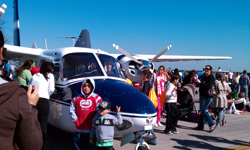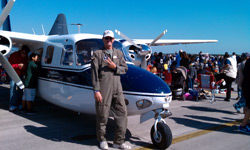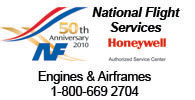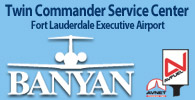SAVING A PIECE OF AMERICAN´┐ŻAND COMMANDER--HISTORY


Pop quiz: Name the lovely shade of blue that distinguishes the Air Force's Presidential fleet. Scott Main knows, at least as it applies to one of the airplanes assigned to the Presidential fleet in the mid-1950s. The improbable answer: Baltic Blue, as in the very same Baltic Blue that Oldsmobile applied to the steel bodies that rolled out of the factory in 1954. Main knows this because of research that he and some sleuths at Twin Commander Aircraft LLC did in preparation for painting the very rare L-26 Commander he owns, has restored, and flies around to air shows.
Main's 1955-vintage Commander is one of 15 the U.S. Air Force bought from Aero Commander for use in the Presidential fleet. It's essentially a Commander 560A with special markings and paint. The story goes that, after he suffered a stroke and was recuperating at his farm in Gettysburg, Pennsylvania, President Dwight D. Eisenhower instructed his staff to get him an airplane that could take off in Washington, fly the 60 or so miles to Gettysburg, and land at his grass strip.
The then-new Aero Commander was the choice, but Air Force brass objected to the President riding in a piston-powered twin. However, when Aero Commander demonstrated the capability and safety of its new twin by removing one of the propellers before taking off from Oklahoma City and flying to Washington D.C., they relented.

Main has obtained the military records of his airplane, which has a pair of serial numbers´┐Ż247 from Aero Commander, and 55-4638 from the Air Force´┐Żand according to its military records it remained in government service until 1973. Its history after being sold as surplus is unclear´┐Żit may have flown weather research missions for the University of North Dakota´┐Żbut eventually it was bought at auction by two Oklahoma men who intended to restore it, Main said. Instead, the airplane languished.
More than a dozen years ago a friend of Main´┐Żs was pressuring him to partner on an airplane. Main, who has been flying for 40 years, has done it all in terms of flying´┐Żhe was an instructor, he repossessed airplanes, he flew as a charter and corporate pilot, he is a lifelong warbird fan and former warbird judge at Oshkosh and Sun 'n Fun, and for the last 30 years he has flown for a major U.S. airline. He grew up working on cars and airplanes´┐Żhe is an A&P´┐Żand had restored a North American T-6 to Oshkosh award-winning condition. But he had tired of the expense and hassle of being a warbird owner and sold the T-6, vowing never to buy another airplane. That did not deter his friend, who said he found an Aero Commander 560A in Oklahoma. ´┐ŻI said 'Geared engines and pressure carburetors´┐Żforget it!' ´┐Ż Main laughs.

´┐ŻIt was in rough shape,´┐Ż he says, but he got it airworthy and flew it for several years before parking it in a hangar at Ft. Lauderdale Executive Airport. The annual inspection and insurance lapsed, and the airplane sat. In 2005 Hurricane Wilma blew through, damaging Main's hangar and the airplane inside.
The storm pushed the hangar door off its rollers, and it fell on the nose of the airplane. The hangar sidewalls collapsed onto the left wing. The wind pushed the airplane into support beams, damaging the flaps. And there was water damage. Although not severe, the damage had to be repaired. Main worked at it, then decided it was time do it right and restore s/n 247 to its 55-4638 Air Force glory.
Getting the paint scheme and markings correct wasn't a problem, but getting the color right was. Main enlisted the help of Twin Commander Aircraft LLC to research obscure records, including military and Aero Commander files. They determined that the Air Force specified the airplanes be painted ´┐ŻBaltic Blue.´┐Ż

Twin Commander's Pam Brown eventually solved the mystery when she found a reference to the color in the Air Force order for the aircraft. It helped identify the color as one used by Oldsmobile on its 1954 cars. ´┐ŻIt was a DuPont Dulux color,´┐Ż Main says.
Mystery solved, Main took the airplane to Robert Loomis at Executive Jet Refinishing in Stuart, Florida. ´┐ŻHe got excited about the project, and went way beyond the call of duty,´┐Ż Main says. Six weeks later the airplane emerged with every bit of the exterior spit, polish, and military bearing it had 55 years ago when Aero Commander handed the airplane over at Bolling Air Force Base.
After it was painted, Main went to work on the inside, gutting the interior. He replaced the original 1970s-vintage interior with leather-covered seats, and installed more contemporary avionics equipment in the panel. ´┐ŻThe panel is not original´┐ŻI updated it slightly,´┐Ż he says, ´┐Żbut I tried to keep as much of the 1955 look as possible.´┐Ż One component he did not have to put much time into was the engines. They had been overhauled years earlier but are still low time and run well. ´┐ŻThe engines were the high point of the project,´┐Ż he says. ´┐ŻTo start one I just prime, hit the starter, and in two blades it's running like a sewing machine. The only issue is ´┐Żsealing endless leaks,´┐Ż´┐Ż he says.

(The National Museum of the U.S. Air Force at Wright-Patterson AFB in Dayton, Ohio, has in its collection the Aero Commander 680 assigned to President Eisenhower. It carries the Air Force designation U-4B.
Main is happy with his decision to restore and fly the Commander. He calls it ´┐Żthe perfect warbird. There's room for six friends, folding chairs, and coolers,´┐Ż he says. ´┐ŻAnd, at the air shows it's a built-in shade tree. Plus, it's a pleasure to fly, and everybody loves it. I get lots of positive comments.´┐Ż
Main stopped going to air shows when he sold the T-6. Now, thanks to the L-26, he's back into it ´┐Żand loving it. My kids fly with me! The project was expensive and very time-consuming, but well worth the effort to save an important chapter of American aviation history.´┐Ż
Discuss this article in the forums...







